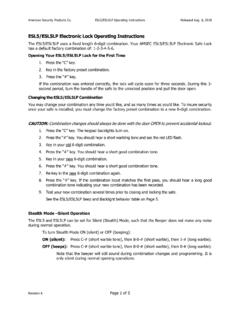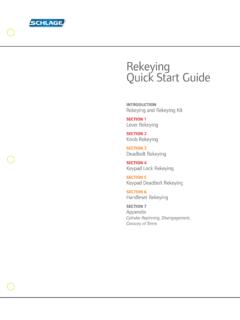Transcription of Understanding Gravity-Flow Pipelines
1 Page 1 of 12 Livestock Watering Order No. January 2006 Understanding Gravity-Flow Pipelines Water Flow, Air Locks and Siphons This Factsheet discusses the problems and solutions of gravity flow pipe system design. Calculating water flow, pipe size, Understanding air locks, and using siphons are covered. Examples and references are given. When looking at energy options available to use when designing a livestock watering system, if gravity energy is available at the site it is usually the first to be considered because it is free energy to: move water in a pipeline (refer to Factsheet # in this Handbook series) provide pressure to a trough frost-protect a trough (refer to Factsheet # in this Handbook series) While water will flow-down-hill , gravity Pipelines have some specific requirements for trouble-free operation. The energy due to gravity at a site is equal to the elevation difference between points, such as between the water supply and the trough site.
2 This elevation difference is termed head with units of feet (for water, more accurately, as feet of head of water). In the case of water, this energy is equal to: 1 foot of elevation drop = psi of pressure head or, for every feet of elevation drop = 1 psi of pressure head Pipe size and flow rate must be matched to this energy using the following steps: the elevation drop or elevation head is measured a flow rate is chosen (refer to Factsheet # in this Handbook series) the end-of-pipe pressure is chosen (refer also to Factsheet #590-304-1) then a pipe size can be chosen (refer to Factsheet # , page 6, Example Gravity System in this Handbook series, for a simple system example) - different pipe sizes and pipe materials will have different flows for a given elevation drop ( , they have different friction losses) ( friction losses are only lost to the water system as energy is converted into heat) The how-much-will-flow question is answered using pipe friction loss tables for the pipe material type and size chosen.
3 All the energy in the elevation head will be used: some to provide the end-of-pipe pressure requirement the rest will be used up as friction to provide a given flow through the pipe Unfortunately, gravity water flow in pipes must be designed to the terrain of a site, so the above is a simplification. If the terrain is a consistent or near consistent grade, one pipe size could be chosen to use the available energy evenly over the full pipe length (as in the above noted Example). But sites often have terrains of varying grades requiring a closer look at pipe sizing requirements, which could include two Introduction How Much Water Will Flow? Hydraulic Theory Page 2 of 12 (or more) pipe sizes. At this point some knowledge of hydraulic theory is needed. The following is a brief and simplified overview of hydraulic theory useful in Understanding gravity water flow in pipes. See the reference material for more detail.
4 Continuity of Flow Principle. This states that for constant water flow in a pipe, flow in one part of a pipe is equal to flow at any other part of the pipe, as shown by: Point A Flow = Point A Velocity x Point A Area, = Point B Velocity x Point B Area, etc As flow is velocity multiplied by pipe area, changing the pipe cross sectional area (a larger or smaller pipe) will cause a change in velocity. This becomes useful when selecting a pipe size or in negative pressure conditions, page 5. Water at Rest. When no water is flowing in a gravity-pressured pipe (as when a trough float valve is closed) it is in static equilibrium. Water levels are at static level and pressures in the pipe are termed static heads. As no water is flowing there is no energy loss to friction and the pressures in the pipe are their highest at all points (equal to their elevation below the inlet), highest pressure being at the lowest point.
5 Water in Motion. When water is flowing in the pipe friction loss occurs that reduces the pressure energy at all points along the pipe. With a constant flow a system is said to be in dynamic equilibrium and pressures are termed dynamic heads. Hydraulic Grade Line. To fully illustrate the conditions along a pipe, static and dynamic equilibrium conditions can be plotted on a drawing of the profile of the system. When the points of static or dynamic equilibrium are connected they form a line that is termed the hydraulic grade line (HGL). This line represents the energy level at each point along the pipe (refer to Figure 1, below). As different flows have different energy levels, they also have different HGL s. Figure 1 Profile of a Gravity-Pressured Water System Supplying a Trough : Hydraulic Grade Line under Static and Dynamic Conditions in Examples 1 and 2 Page 3 of 12 The HGL for static equilibrium is a horizontal line at the level of the water source, as in static conditions the pipe has an energy level equal to its elevation below this water source elevation (no friction loss is occurring).
6 The HGL for dynamic equilibrium is a line sloped downwards from the water inlet to either the pressure at the trough float valve or to zero if the outlet flow is to atmosphere. This line always slopes downward, indicating a loss of energy as water flows downhill and energy is lost due to friction. Friction. When water is flowing in the pipe energy is lost by the friction of water against the pipe and fittings, and as it enters and exits the pipe, including such obstacles as air trapped in the pipe (see Air Locks, page 6) and is determined by: the pipe wall roughness the velocity of the water (the flow rate through a given pipe diameter) minor (usually) things like fittings, water temperature, suspended particles, etc For a given pipe size, the greater the flow - the greater the velocity - the greater the energy loss by friction. Friction losses are not linear - doubling the flow may increase the friction loss by up to four times.
7 This energy loss cannot be recovered. As energy in a gravity system is fixed by the elevation difference present, lost energy due to friction is usually an important design factor. Pipe size is selected to match pipe friction loss to the available head to achieve the desired water flow rate. When gravity-pressured water is flowing in a pipe that discharges to the atmosphere (say freely into the top of a trough) the maximum flow is occurring. This means the elevation head is all being converted to friction loss. This flow rate can be determined by using the friction loss table (Table 2, Factsheet # ): the elevation head (ft) is measured and converted to psi (ft divided by = psi) the pipe length (ft) is measured the available energy for friction loss is calculated - elevation head divided by pipe length, expressed as psi per 100 ft (psi/100 ft) this value is located on the friction loss table under the column for the pipe type and size and the flow rate for those conditions is read Note that systems that use a float valve will require some pressure head at the trough that will reduce the energy available for friction thereby reducing the flow below that of the natural rate.
8 Refer to Example 2, next page, and to Factsheet # , page 6, Example Gravity System in this Handbook series, for examples. Example 1 Natural Flow A system is planned that has a 75 feet elevation head and will use 1 inch polyethylene (PE) pipe that is 1200 feet long free flowing into a trough as shown in Figure 1. What will be the natural flow? information given: 75 ft elevation head: divided by = psi; and the pipe length is 1200 ft available energy for friction loss is psi divided by (1200 ft / 100) = psi/100 ft of pipe determine flow rate: from Table 2, page 5, Factsheet # , a 1 inch PE pipe with a friction loss of psi/100 ft will have a flow rate of just under 10 USgpm this natural flow rate of 10 USgpm is the maximum this system can deliver to the trough with a 1 inch PE pipe - if a greater flow is required a larger pipe must be selected ( , a 1 inch PE pipe on this site would flow just over 20 USgpm) note: these flow rates are preferred rates for these pipes - they are in the Table 2 shaded area indicating these flow rates have velocities less than 5 ft/sec, the normal maximum design velocity Natural Flow Page 4 of 12 When a single pipe size does not give the desired friction loss, two pipes will be needed.
9 The following combination Pipe Size Equation, derived from the Continuity of Flow Principle, is much quicker than the trial and error method of calculation where various pipe lengths are tried. It is used to calculate pipe lengths for a desired flow rate, when the total head and the total pipe length are known and two pipe sizes have been selected: Smaller Pipe Length = 100 x H - (Flarge x L) Fsmall - Flarge Where: H = the total head available for friction loss (ft) L = total pipe length (ft) Flarge = % friction loss in the larger pipe (psi per 100 ft x ) Fsmall = % friction loss in the smaller pipe (psi per 100 ft x ) The length of the larger pipe (ft) = L minus the calculated Smaller Pipe Length Note that H is the total head available for friction loss it is reduced for any pressure required at the delivery end of the pipe, such as at a trough. Also note that this equation does not take into account severe grade changes which can have specific pipe sizing requirements (see Negative Pressure, next page).
10 Example 2 combination Pipe Sizing Using the same conditions as Example 1, (75 feet elevation head, using 1200 feet of 1 inch polyethylene pipe supplying a trough), but instead of free flowing, a trough pressure of 15 psi is required, as shown in Figure 1. What pipe size(s) are needed for a 10 USgpm flow? information given: 75 ft elevation head; and the pipe length is 1200 ft trough requires 15 psi x = 35 ft for trough pressure elevation head available for friction loss = 75 ft - 35 ft trough pressure = 40 ft of head calculate the available friction loss over the 1200 ft - 40 ft / ft/psi = psi; over the 1200 ft = / (1200 / 100) = psi/100 ft calculate the flow rate and select the two pipe sizes to be used - from Table 2, Factsheet # , psi/100 ft in 1 inch pipe equates to a flow rate of 7 USgpm - as this system has to deliver 10 USgpm, a larger pipe is required try 1 inch - 1 inch has psi/100ft friction loss at 10 USgpm, so a combination of 1 & 1 inch pipe is needed use the combination Pipe Size Equation to select the pipe lengths for an 10 USgpm flow rate: - 1 inch pipe at 10 USgpm = psi/100ft friction loss x ft/psi = ft / 100 ft = - 1 inch pipe at 10 USgpm = psi/100ft friction loss x ft/psi = ft / 100 ft = Smaller (1 inch) Pipe Length = (100 x 40 ft) - ( x 1200 ft) = 432 ft of 1 inch pipe ( ) - ( ) Larger (1 inch) Pipe Length = 1200 ft - 432 ft = 768 ft of 1 inch pipe solution.









